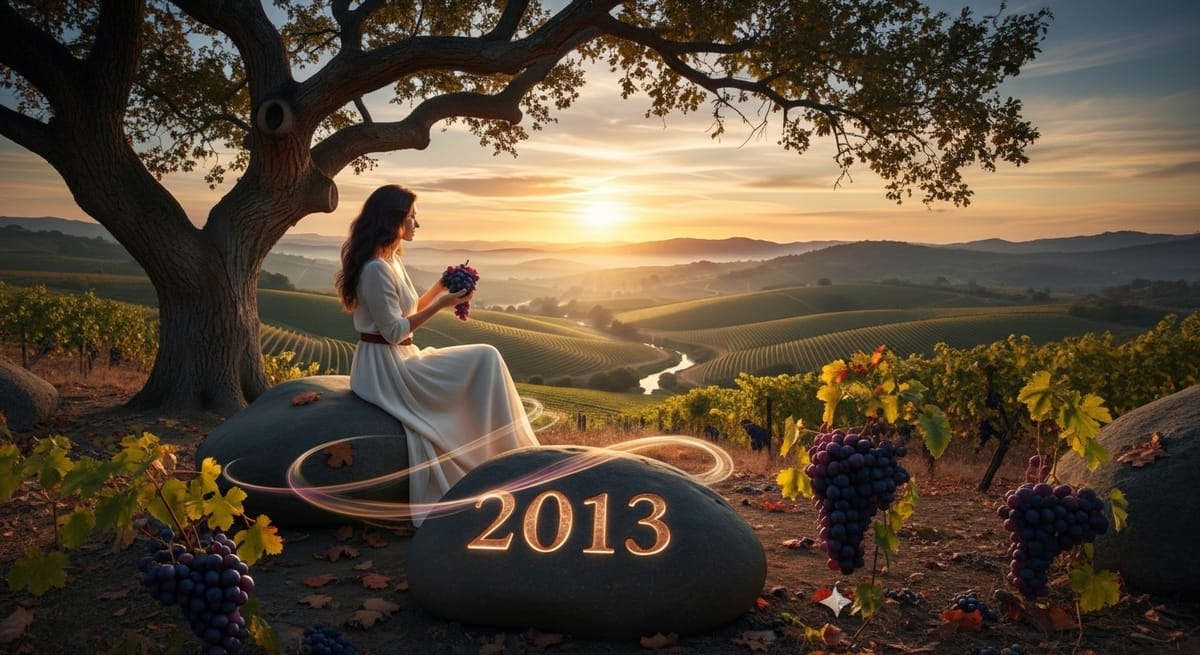2013 Napa Cabernet: A Silent Summer That Sang on the Vine
Explore Napa Cabernet 2013: dry winter, even warmth, small berries, cool nights. Concentration with freshness—cassis, graphite, cedar. AVA snapshot, winemaking choices, producer standouts, and clear drink-or-hold windows for a long, confident cellar life.

The Year the Earth Stood Still
The 2013 Napa Cabernet vintage is a masterclass in concentration achieved through balance, not excess. The story began with a conspicuously dry winter, setting the stage for an early, vigorous budbreak that rang like a clear bell in spring. The growing season that followed was a rare gift: warm, even, and almost seismically calm. This steady heat, tempered by the cooling breath of fog that snaked up from San Pablo Bay, allowed the tiny berries to develop an extraordinary skin-to-juice ratio. The skins thickened, rich with color and tannin, while the cool nights preserved a vital acid line—that structural spine that whispers of longevity. The picks, beginning as early as late August and continuing through the measured cool of mid-October, were a mosaic of highly selective passes, only allowing perfectly mature clusters to enter the winery. The core of this vintage is that the growers, by nature of the consistent weather, could play the long game. Their stakes were clarity and density.
The Architect's Blueprints
The 2013 vintage immediately cemented its place in the modern Napa canon, landing somewhere between the plush charm of 2012 and the focused intensity of 2014. It is defined by its architectural firmness. Where 2012 was open-armed, 2013 is a folded map: deeply ripe but tightly wound. The extraordinary diurnal range—the swing between hot days and cold nights—was the key, locking in freshness even as the tannins ripened fully. This balance, coupled with the small berry size, gifted the wines an uncommon density and site clarity, marking them for a long, confident life in the cellar. This is a vintage built not for a sprint, but for the steady, unfolding journey.
From Silk to Suede: The Palate's Story
These wines move with a powerful, yet contained grace. The fruit is a concentrated core of crushed cassis, blackberry liqueur, and black cherry, which then gives way to the mineral landscape beneath. Note the coolness of graphite dust, the savory shade of cedar box, the refreshing lift of bay laurel, and the dark velvet whisper of high-grade cocoa. On the palate, the tension is palpable: the texture begins with a sleek silkiness before the tannins take hold, turning from silk into a densely woven suede. The signature of 2013 is this tension, a lighthouse wrapped in velvet, its core beam bright and direct. Cabernet Sauvignon, in 2013, squares its shoulders, then nods with mint-cool restraint to its blending friends—Cabernet Franc, Merlot, and Petit Verdot—allowing them to soften the edges without diluting the core message.
A Cartography of Light and Shadow
Traveling Napa in 2013 is like traversing a landscape carved in dark stone. In Rutherford, the wines sing of breadth and that unmistakable "dust" thread—a savory, earthen character that roots the ripe fruit, particularly evident on the west-side benchlands like the venerable Inglenook or Scarecrow sites. Oakville demonstrates a polished, nearly aristocratic grace, balancing powerful breadth with seamless texture; the wines from the west bench carry a floral perfume, while the east bench tends toward a darker, more iron-rich core. Stags Leap District wines are defined by their deep violet perfume and fine-boned, almost powdery tannin, like a cool canyon breeze caught in the glass.
The high-elevation sites speak a sterner language. Howell Mountain delivers power wrapped in earth and herbal graphite; Mount Veeder offers muscular tannins and deep, cool cores; and Spring Mountain wines are layered, showing a balance of intense fruit and savory mountain lift. Down south, Coombsville offers a distinctive cooler arc, expressed in a blue-fruit glow and a volcanic, savory edge. Moving back north, Calistoga, St. Helena, and Yountville all show the warmth of the valley floor in a ripeness of dark fruit and spice, but the best maintain the vintage's structural tension, noting the site differences: Calistoga’s heat, St. Helena’s spiced charm, and Yountville’s measured balance. The real dark horse of the vintage? Pockets of old-vine Cabernet Franc planted on the higher, wind-brushed benches that over-delivered with incredible clarity.
The Winemaker's Gentle Hand
The consistent beauty of 2013 provided winemakers with a rare degree of creative freedom. Decisions around pick dates were often the first lever, with earlier picks preserving higher acid and savory freshness, while later picks pushed the ripeness envelope. Careful sorting intensity was non-negotiable to handle the concentrated berries. The gentleness of extraction—often achieved via a careful "cold soak" (pre-ferment maceration for color without harshness) and gentle pump-overs—determined the eventual texture of the tannins. Oak choices mattered deeply, with top producers favoring 80–100% new French barrique (the traditional 225-liter format), but increasingly focused on the quality and toast of the wood to support, not suppress, the fruit. While alcohol levels often landed in the 14.5–15.5% range, the defining feature is that the vintage's innate structure kept the heat in check, ensuring the wines felt balanced, not heavy, and that the original terroir remained delightfully audible.
The Voices of the Vintage
Certain vintners seized the crystalline clarity of 2013 to craft wines that are already benchmarks for the decade.
Icons: The sheer density and focus of Dominus speak to the ripeness achieved without loss of terroir definition. Spottswoode stands out for its seamless integration of power and perfume, showing that cool-core elegance. The best lots from Shafer Hillside Select display a black, iron-fisted concentration married to a surprising freshness.
Value Plays: Forman Vineyard captured the cool tension and mineral lift that mark the vintage’s structural prowess, offering remarkable cellar-worthiness. Frog’s Leap delivered its signature elegant, dry-farmed style, which, in 2013, gained an extra layer of structural firmness. Smith-Madrone, high up on Spring Mountain, bottled a high-elevation classic: rugged, herbal, and built to last.
Wild Cards: The tiny-production, highly selective lots from Kapcsándy Family Winery demonstrate the vintage’s ability to achieve both richness and linear drive. Memento Mori focused on low-intervention methodology applied to high-end sites, resulting in wines of intense purity and dark-fruit focus. These are wines that trade the grand statement for the intimate monologue.
The Unfolding Decades
The great structural clarity of the 2013 vintage means its aging curve is long and rewarding. The key, as ever, is understanding the wine’s personality.
Early Charm (Now–2029): The wines are currently in a dense, powerful phase, showing primary fruit intensity. Decanting is essential for several hours to allow the concentrated tannins to soften and the wine to breathe out its youthful energy. Use large, wide-bowled stems.
Sweet Spot (2030–2048): This is the window where the fruit will move from primary concentration to a complex tertiary profile: cedar, leather, cigar box, dried bay. The tannins will have fully resolved into that fine-suede texture. Expect unparalleled harmony and a quiet brilliance.
Marathon (2049+): The best, most structured mountain and select benchland wines have the stuffing for a half-century or more. For those who seek the meditative, autumnal character of fully mature Cabernet, keep these deep in the coldest reaches of the cellar.
The Final Measure
The 2013 Napa Cabernet vintage is a crystalline affirmation that the valley's magic rests not in brute force, but in power through precision. It is a coiled spring of dark fruit and firm, ripe tannin, its deep structure promising a silent transformation in the quiet dark of the cellar. This is a vintage demanding both patience and respect, offering an unfolding story that rewards every decade—a conversation with the past and a hopeful glance toward the future, inviting us to contemplate how place, time, and the human hand can translate a simple season into liquid wisdom.





